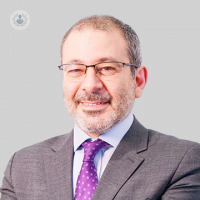What should I do if I think I have acid reflux?
Written by:Acid reflux is a common condition that occurs when acid from the stomach travels up into the oesophagus (food pipe), sometimes as far up as the throat. Symptoms can present in a variety of ways including, heartburn, regurgitation, chest pain, sore throat, hoarse voice, throat clearing, cough and shortness of breath. Usually, symptoms are temporary or can be treated with over-the-counter medicines but sometimes, supervised medical treatment is necessary. If symptoms remain troublesome, it would be important to see a doctor to either supervise your medical treatment and/or determine if your reflux would benefit from further testing with a view to confirming the diagnosis and possibly being treated more actively. Also, it is important not to miss symptoms that should require testing to exclude other more serious causes.
In this article, Dr Rami Sweis, leading consultant gastroenterologist with extensive experience in upper and lower gastrointestinal disorders, explains the role of testing and options for treatment in those who present with reflux.

What are the types of reflux?
Firstly, it is important to understand that having symptoms of reflux does not necessarily imply that there is acid reflux disease. In order to treat patients with short term causes of acid reducing medicines, one does not always need to prove the presence of reflux disease. Reflux is common in the community with up to 20 per cent of the western world complaining of reflux-like symptoms. Initially, simple acid-reducing medicines and reassurance, is sometimes all that is required. However, if symptoms remain troublesome, or, come back after stopping medicines or if you are concerned, the decision of what to do next is best determined together with a doctor. If there are no concerning features, treatment of typical symptoms of heartburn or regurgitation can be undertaken with an appropriate combination of antacids (such as Gaviscon) and acid reducing medications (such as omeprazole, also known as proton pump inhibitors). If symptom response is not sufficient or if further escalation of treatment is required, there are other options, but an assessment of the oesophagus and the way it works is needed to measure how much reflux is taking place. There are a variety of ways to do this, each test providing important yet different information about your oesophagus, the choice of which will be decided together with your doctor:
1. Endoscopy
It is important to have an endoscopy before any further tests are undertaken. Endoscopy helps to exclude obvious causes of symptoms, such as inflammation and ulceration, as well as to exclude other conditions that can ‘mimic’ reflux. Barrett’s oesophagus is a condition whereby the mucosa (skin of the oesophagus) changes to become similar to that of the stomach. If found, surveillance endoscopy will be needed in the future as there is a small risk of this developing into something more serious. Such conditions can only be seen with a camera which also allows for small, pain-free biopsies to be taken so that they can be analysed under the microscope. Of course, an endoscopy is also required to exclude more worrying conditions which - although uncommon - must be identified as early as possible as there are treatments that can be offered when discovered in the early stages.
Endoscopy can be performed with throat spray with you awake or it can be undertaken after you have had something to help you relax and sleep or even under general anaesthetic. You will never need to ‘swallow’ the camera; the doctor does everything. The procedure is normally quick and takes no more than 7 minutes.
2. High resolution manometry
It is important to understand how the oesophagus works whilst actually eating and drinking. A very thin, floppy tube with pressure sensors is passed from the nose to the stomach. Patients are then asked to swallow water and then food (for example, rice). It is a 20-minute test and is normally well tolerated and not very uncomfortable. The tube is removed as soon as the test is complete. The patient can also often watch the trace as it is produced as images appear live and instantaneously, even allowing patients to take part in describing what is happening.
3. Impedance-pH monitoring
This normally follows manometry whereby an even thinner tube is passed in the same way, but this tube has pH and other sensors that measure acid and non-acid reflux. This tube stays in place for 24 hours so that all reflux is recorded onto a receiver that the patient carries. The patient also presses buttons on the receiver to help inform it when symptoms are happening. Afterwards, the patient returns the recorder and the tube can be easily removed. Again, this is normally well tolerated and painless.
4. Wireless pH monitoring
If patients prefer not to have the tube through the nose for 24 hours, there is another wireless pH test whereby a capsule is attached to the bottom of the oesophagus during an endoscopy. This capsule has a sensor that measures acid continuously, which it wirelessly sends to a receiver. Just like with the catheter test, the patient presses buttons to tell the receiver when symptoms are happening and what these are. This capsule measures acid reflux for a maximum of 4 days and then drops off on its own. The capsule is also normally painless.
All tests will be discussed with you by the doctor to ensure that everything is clear and that you are happy to proceed with the appropriate tests should they be recommended or required.
How do you treat reflux when medicines are not enough? What are the anti-reflux procedures?
If medicines are not enough to treat symptoms and if other conditions that can mimic reflux have been excluded, there are other options for treatment of reflux, which are also known as ‘anti-reflux procedures’. However, none of these can be considered before reflux is proven with one or more of the tests listed above. If reflux is confirmed, anti-reflux procedures that can be offered are as follows:
1. Anti-reflux surgery
Also known as fundoplication, a referral to the surgeon is made to consider wrapping the top of the stomach in a way that recreates and strengthens the valve (or sphincter) that is allowing for reflux to take place.
2. Stretta
This procedure allows for energy to be transmitted to the lower oesophagus with the aim of reducing sensitivity of the oesophagus to reflux.
3. Trans-oral incisionless fundoplication
This procedure is similar to the fundoplication but is undertaken entirely through the endoscope without the need for surgery. The aim is to recreate and strengthen the valve that is allowing reflux to occur. It also appears to be associated with less side effects that might occur following surgery (such as bloating).
The decision of which of these treatments is undertaken needs thorough discussion with the doctor to determine the risks, merits and benefits of each, as treatment options will depend on the symptoms, the test findings and the oesophagus anatomy. In other words, it will be different for each patient.
What kind of lifestyle modifications can people with acid reflux make?
There is a lot that one can do to help symptoms with simple lifestyle manoeuvres. Many of these works well but there is little evidence that one should follow a strict guideline or follow a ‘low acid diet’ leaflet, as many are restrictive and unnecessary and can have a poor impact on quality of life - sometimes more than the symptoms of reflux. On the other hand, weight loss has a clear benefit. A consultation with the doctor is important to determine the best lifestyle modification to consider and how to combine this with medicines as appropriate. What is most important, however, is that patients should maintain a good quality of life, and a good doctor will always have that in mind when offering treatment advice.
There are a number of other conditions that can present in a way that is similar to acid reflux, even test positive on the test, but they are not always due to reflux disease or might have treatment options that are different to that of acid reflux disease. It is important to identify these because treatment is not always the same. Such conditions include the following:
1. Symptoms that are exclusively or primarily in the back of the throat, also known as laryngo-pharyngeal reflux (LPR). These include sore throat, hoarse voice, throat clearing, even shortness of breath and cough. Patients are often told that these are due to reflux, but that is not always the case, especially when the more typical symptoms of heartburn and regurgitation are not also present. In this case, tests might be required to prove if they are due to reflux or due to something entirely different.
2. Belching conditions can lead to reflux because of food or fluid rising along with the air that is coming up. There are a number of different types of belch conditions, such as aerophagia and supragastric belching. In such cases, the belching problem needs to be the target of treatment rather than the reflux, whilst reflux is in fact the consequence rather than the cause.
3. Gastroparesis and vomiting disorders will also lead to reflux of stomach contents into the oesophagus, but the problem is not the reflux, rather, the problem is from the stomach and beyond. In this case, treatment should be aimed at the stomach rather than the oesophagus.
4. Subconscious behaviours that can mimic reflux and regurgitation include conditions such as Rumination syndrome. This is an under-recognised, but important condition, which can be fairly common and yet often missed because it can also be associated with regurgitation and heartburn. It might be tricky to differentiate unless your doctor is experienced in identifying this disorder and treating it, but treatment with anti-reflux procedures would be inappropriate if it is misdiagnosed as reflux disease.
5. Hypersensitivity is where the oesophagus is sensitive to normal levels of reflux (we all reflux up to a degree). Treatment is therefore aimed at the sensitivity, not at the reflux disease.
6. Oesophageal motility disorders can mimic reflux but in fact the problem lies with the way the oesophagus works and clears the oesophagus. It is important not to miss a motility disorder, especially if it is a progressive one.
Your doctor should be able to differentiate between all of these conditions, with the aim of knowing what to look for and which tests to consider usually from initial consultation. The next steps should then be determined carefully, so that you are comfortable and convinced that the tests being offered are the right ones for you and are being arranged to answer the right questions. Not all patients or symptoms are the same and so every test and treatment should be individualised so that you never have anything done or offered that you are not entirely convinced and satisfied with.


